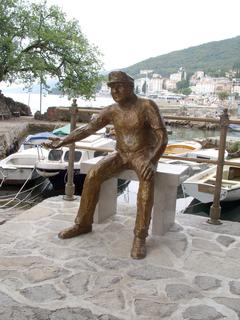Barkajol je simbol Opatije
Opatija je u srpnju 2012. dobila brončanu skulpturu Barkajola, također rad akademske kiparice Tatjane Kostanjević.
Opatija slovi za mondeno mjesto odmora gdje su u prošlosti svoju inspiraciju crpile poznate ličnosti poput Isadore Duncan, Čehova, Mahlera, Jana Kubelika i premda je Opatija postavile skulpture svim tim slavnim gostima, a koje je izradila Tatjana Kostanjević, gradske su vlasti ovoga puta odlučile postaviti skulpturu običnim malom čovjeku.
Barkajol je simbol Opatijskog turizma koje je pjesnik Drago Gervais opisao u pjesmi "Bitteschen barkefahren".
Skulptura Barkajola postavljena je na opatijskoj šetnici „Lungo mare“ u čast svih onih ljudi koju su strpljivo, godinama, vozili turiste svojim barkama i pokazivali im ljepote naše obale kako bi zaradili koji novčić.
Ta je skulptura kod ljudi doživjela veliki uspjeh. Od fotografiranja i sjedenja u zagrljaju skulpture izlizana je ruka i butina Barkajola.
Pokazalo se da ljudi vole urbane skulpture koje su im i formom i sadržajem bliske. Čak se poistovjećuju s njima u koliko one zrače ljudskošću. Stoga je dobro da se postavljaju.
Barkajol is the Symbol of Opatija
In July 2012 Opatija got a bronze sculpture of Barkajol, which is also a work of art from the academic sculptress Tatjana Kostanjevic.
Opatija is a renowned holiday place where many famous people throughout the history came to be inspired, like Isadora Duncan, Chekov, Mahler, Jan Kubelik. Even though Opatija put up many sculptures to homage all those famous guests, and which were made by Tatjana Kostanjevic, the local authorities decided this time to put up a sculpture to an ordinary man.
Barkajol is a symbol of Opatija's tourism which Drago Gervais depicted in his song „Bitteschoen Barkefahren“.
The sculpture of Barkajol is put up on the footpath 'Lungo Mare' in honour of all those people who have patientily, throughout the years, driven toursits in their boats and shown them the beauties of our coast in order to earn some money.
This sculpture has become very popular. The hand and hip of Barkajol became shiny from taking photographs or sitting down on the bench next to him and hugging him.
This is to prove that people love urban sculptures which they could relate with either by form or content. Some even identify themselves with the sculptures if they are humane enough. That's why it is good to put them up.

















